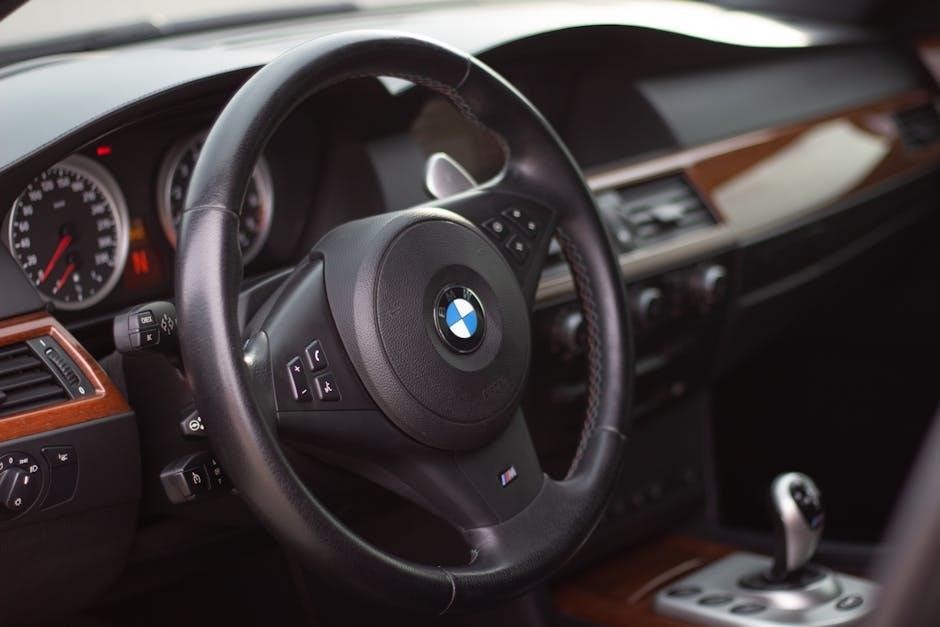Automatic and manual cars offer different driving experiences, with automatic cars providing ease and manual cars offering control, using transmissions to facilitate gear shifting, making them popular among drivers today always.
Definition of Automatic and Manual Transmissions
A transmission is a mechanism that transmits power from the engine to the wheels of a car, using gears to adjust the speed and torque of the power. Automatic transmissions use a complex system of sensors, hydraulic pumps, and planetary gears to automatically change gears, while manual transmissions require the driver to manually change gears using a clutch pedal and gearshift. The main difference between the two is the level of driver involvement, with automatic transmissions providing a more convenient and effortless driving experience, and manual transmissions offering more control and engagement. In terms of definition, an automatic transmission is a type of transmission that can change gears without driver input, while a manual transmission requires the driver to manually change gears. This definition is important to understand the differences between automatic and manual cars, and how they operate. Using transmissions to facilitate gear shifting, making them popular among drivers today, with various types of transmissions available, including semi-automatic and continuously variable transmissions.

History of Semi-Automatic Transmissions
Semi-automatic transmissions originated in the 1930s with early versions, using clutch systems, evolving over time to become more efficient and reliable always.
Evolution of Semi-Automatic Transmissions Over the Decades
The evolution of semi-automatic transmissions has been a gradual process, with significant advancements over the decades, incorporating new technologies and innovations to improve performance and efficiency.
The early versions of semi-automatic transmissions were relatively simple, but as time passed, they became more complex and sophisticated, with the introduction of electronic controls and automated clutch systems.
The use of computerized systems and sensors has enabled semi-automatic transmissions to adapt to different driving conditions, providing a smoother and more responsive driving experience.
The development of semi-automatic transmissions has also been influenced by the need for improved fuel efficiency and reduced emissions, leading to the creation of more environmentally friendly and cost-effective solutions.
Overall, the evolution of semi-automatic transmissions has transformed the way cars are driven, offering a unique blend of convenience, control, and performance, and continuing to shape the future of the automotive industry.
With ongoing research and development, semi-automatic transmissions are likely to continue evolving, incorporating new technologies and innovations to meet the changing needs of drivers and the environment.

Key Characteristics of Semi-Automatic Cars
Semi-automatic cars have unique features, including automated clutch systems, combining manual and automatic elements, always providing a distinct driving experience with various benefits and advantages every day.
Blending Qualities of Manual and Automatic Shifting
Semi-automatic cars blend the qualities of manual and automatic shifting, providing a unique driving experience, with the convenience of automatic transmissions and the control of manual gearboxes, allowing drivers to select gears manually, while the clutch is automated, making it easier to drive in heavy traffic or hilly terrain, and also providing better fuel efficiency, as the driver can control the gear shifting, and the automated clutch system reduces the wear and tear on the clutch, and the driver can also enjoy the thrill of manual shifting, with the ease of automatic transmission, making semi-automatic cars a popular choice among drivers, who want to experience the best of both worlds, with the flexibility to switch between manual and automatic modes, depending on the driving conditions, and the driver’s preference, and the semi-automatic transmission also provides a smooth and seamless shifting experience, making it a joy to drive.

Operation of Semi-Automatic Transmissions
Semi-automatic transmissions operate using a complex system of electronics and mechanics to facilitate smooth gear shifting always.
Role of the Driver in Semi-Automatic Cars
The driver plays a significant role in semi-automatic cars, as they are responsible for manually changing gears using a lever or buttons. This allows the driver to have control over the gear shifting process, which can be beneficial in certain driving situations. The driver must also be aware of the road conditions and adjust their driving accordingly, taking into account the traffic and weather conditions. In addition, the driver must be able to use the clutch and accelerator pedals in conjunction with the gear shifting mechanism to ensure smooth and efficient driving. Overall, the driver’s input is crucial in semi-automatic cars, and their ability to adapt to different driving situations is essential for safe and effective operation. The driver’s role is to balance the convenience of automatic transmissions with the control of manual gearboxes, making semi-automatic cars a unique and challenging driving experience.
Pros and Cons of Semi-Automatic Cars
Semi-automatic cars offer convenience and control with unique features and some drawbacks always present in these vehicles.
Unique Driving Experience and Fuel Efficiency
Semi-automatic cars provide a unique driving experience, combining the convenience of automatic transmissions with the control of manual gearboxes, using a clutch system that is automated, allowing for smooth gear shifts. The driver can select the desired gear using a lever or buttons, giving them more control over the vehicle. This unique driving experience is one of the main advantages of semi-automatic cars, making them popular among drivers who want a mix of convenience and control. Additionally, semi-automatic cars are often more fuel-efficient than fully automatic cars, as they allow the driver to select the most efficient gear for the current driving conditions. This can lead to significant savings on fuel costs, making semi-automatic cars a cost-effective option for many drivers. Overall, the unique driving experience and fuel efficiency of semi-automatic cars make them an attractive option for many drivers, offering a compromise between convenience and control.

Comparison with Fully Automatic and Manual Cars
In comparison to fully automatic and manual cars, semi-automatic cars offer a unique blend of features, using advanced technology to provide a smooth driving experience. Fully automatic cars, on the other hand, offer a more convenient driving experience, but can be less fuel-efficient and less engaging to drive. Manual cars, by contrast, offer more control and a more immersive driving experience, but can be more difficult to drive in heavy traffic. Semi-automatic cars, therefore, occupy a middle ground, offering a compromise between convenience and control. This makes them an attractive option for drivers who want a mix of ease and engagement, and are willing to pay a premium for advanced features. Overall, the comparison between semi-automatic, fully automatic, and manual cars highlights the unique strengths and weaknesses of each type, and allows drivers to choose the best option for their needs and preferences, using online reviews and test drives to inform their decision. Semi-automatic cars are a viable option for many drivers, offering a unique combination of features and benefits.


